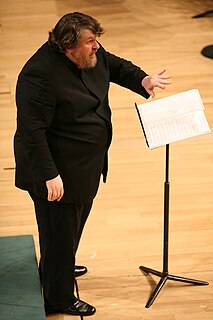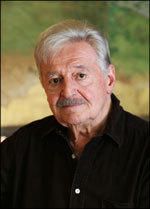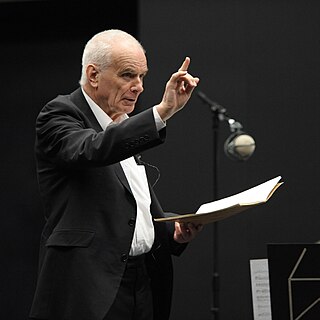Related Research Articles

Stuart Oliver Knussen was a British composer and conductor.

Capriccio espagnol, Op. 34, is the common Western title for a five movement orchestral suite, based on Spanish folk melodies, composed by the Russian composer Nikolai Rimsky-Korsakov in 1887. It received its premier on 31 October 1887, in St. Petersburg, performed by the Imperial Orchestra conducted by the composer. Rimsky-Korsakov originally intended to write the work for a solo violin with orchestra, but later decided that a purely orchestral work would do better justice to the lively melodies. The Russian title is Каприччио на испанские темы.

The Swan of Tuonela is an 1895 tone poem by the Finnish composer Jean Sibelius. It is part of the Lemminkäinen Suite, Op. 22, based on the Finnish mythological epic the Kalevala.

Peter Joshua Sculthorpe was an Australian composer. Much of his music resulted from an interest in the music of Australia's neighbours as well as from the impulse to bring together aspects of native Australian music with that of the heritage of the West. He was known primarily for his orchestral and chamber music, such as Kakadu (1988) and Earth Cry (1986), which evoke the sounds and feeling of the Australian bushland and outback. He also wrote 18 string quartets, using unusual timbral effects, works for piano, and two operas. He stated that he wanted his music to make people feel better and happier for having listened to it. He typically avoided the dense, atonal techniques of many of his contemporary composers. His work was often distinguished by its distinctive use of percussion.
The Desert Music is a work of music for voices and orchestra composed by the minimalist composer Steve Reich. It is based on texts by William Carlos Williams and takes its title from the poetry anthology The Desert Music and Other Poems. The composition consists of five movements, with a duration of about 46 minutes. In both its arrangement of thematic material and use of tempi, the piece is in a characteristic arch form (ABCBA). The piece was composed in 1983 and had its world premiere on 17 March 1984 in Cologne, Germany.

The Symphony No. 8 in G major, Op. 88, B. 163, is a symphony by Antonín Dvořák, composed in 1889 at Vysoká u Příbramě, Bohemia, on the occasion of his election to the Bohemian Academy of Science, Literature and Arts. Dvořák conducted the premiere in Prague on 2 February 1890. In contrast to other symphonies of both the composer and the period, the music is cheerful and optimistic. It was originally published as Symphony No. 4.
The Bachianas Brasileiras are a series of nine suites by the Brazilian composer Heitor Villa-Lobos, written for various combinations of instruments and voices between 1930 and 1945. They represent a fusion of Brazilian folk and popular music on the one hand and the style of Johann Sebastian Bach on the other, as an attempt to freely adapt a number of Baroque harmonic and contrapuntal procedures to Brazilian music. Most of the movements in each suite have two titles: one "Bachian", the other Brazilian.
Possible Sky is a composition for choir and orchestra by the American composer Meredith Monk. The work was commissioned by the conductor Michael Tilson Thomas and the New World Symphony. It was first performed April 4, 2003 in Miami Beach, Florida by Thomas and the New World Symphony. The composition was Monk's first work for orchestra.
The Berserking is a concerto for solo piano and orchestra by the Scottish composer James MacMillan. The work was commissioned by the Musica Nova Festival and was premiered in Glasgow on 22 September 1990 by the pianist Peter Donohoe and the Royal Scottish National Orchestra under the conductor Matthias Bamert.
The Concerto for Orchestra is an orchestral composition by the American composer Joan Tower. The work was jointly commissioned by the St. Louis Symphony, the Chicago Symphony Orchestra, and the New York Philharmonic.
The Cello Concerto No. 3, Legend of the Phoenix, is a composition for cello solo and orchestra by the American composer Augusta Read Thomas. The work was commissioned by the Boston Symphony Orchestra with contributions from Bill and Solange Brown. It was first performed in Boston on March 14, 2013, by the cellist Lynn Harrell and the Boston Symphony Orchestra under the conductor Christoph Eschenbach. Thomas subsequently adapted the piece into a viola concerto in 2013.
The Concerto for Piano is a composition for solo piano and orchestra by the American composer Elliott Carter. The work was commissioned by the pianist Jacob Lateiner with support from the Ford Foundation. It was composed between 1964 and 1965 and was first performed at Symphony Hall, Boston on January 6, 1967, by Lateiner and the Boston Symphony Orchestra under the conductor Erich Leinsdorf. The piece was dedicated to the composer Igor Stravinsky for his 85th birthday.
Interventions is a composition for solo piano and orchestra by the American composer Elliott Carter. The work was composed at the behest of the pianist Daniel Barenboim and the conductor James Levine to celebrate Carter's 100th birthday. The piece was completed on April 16, 2007 and was first performed in Symphony Hall, Boston on December 4, 2008 by Daniel Barenboim and the Boston Symphony Orchestra under James Levine.

The Concerto for Trumpet and Orchestra is a composition for trumpet solo and orchestra by the British composer Peter Maxwell Davies. The work was commissioned by the Philharmonia Orchestra for its then principal trumpeter John Wallace. It was given its world premiere by Wallace and the Philharmonia Orchestra under the conductor Giuseppe Sinopoli in Hiroshima on 21 September 1988.
The World's Ransoming is a concerto for cor anglais and orchestra by the Scottish composer James MacMillan. It was the first of three interrelated compositions in MacMillan's Easter triptych Triduum commissioned by the London Symphony Orchestra. Its world premiere was given by the soloist Christine Pendrill and the London Symphony Orchestra under the direction of Kent Nagano at the Barbican Centre on 11 July 1996.
Campane di Ravello is a short orchestral composition by the American composer John Corigliano. The work was commissioned by the Chicago Symphony Orchestra for the 75th birthday of its then music director Georg Solti. Its world premiere was given by the Chicago Symphony Orchestra under the direction of Kenneth Jean on October 9, 1987.

Memento Mori (1993) is a composition for orchestra by Peter Sculthorpe. The title refers to the medieval Christian idea of memento mori, and the piece itself makes frequent references to the plainchant setting of the Latin hymn "Dies irae".
Sept haïkaï — esquisses japonaises are a composition for piano and small orchestra by Olivier Messiaen. The set were published by Alphonse Leduc in 1966 and subsequently republished numerous times. They last about twenty minutes on average.

The Triumph of Time, sometimes also referred to as Triumph of Time, is a composition for orchestra by British composer Harrison Birtwistle written 1971 and 1972. It is one of Birtwistle's best-known compositions, as well as one of the works that earned him international reputation.
The Trombone Concerto is a composition for trombone and orchestra written by the Scottish composer James MacMillan. The work was commissioned by the Royal Concertgebouw Orchestra for their principal trombonist Jörgen van Rijen and co-commissioned by a consortium of orchestras comprising the Dallas Symphony Orchestra, Royal Flemish Philharmonic Orchestra, the Orchestre de la Suisse Romande, the Oulu Symphony Orchestra, and the Philharmonisches Orchester des Staatstheaters Cottbus. It was first performed by Jörgen van Rijen and the Royal Concertgebouw Orchestra under the direction of Iván Fischer at the Concertgebouw, Amsterdam, on 20 April 2017. The piece is dedicated to Jörgen van Rijen and in memory of Sara Maria MacMillan, the composer's granddaughter, who died shortly before its composition.
References
- ↑ Richards, Fiona (2007). The soundscapes of Australia: music, place and spirituality. Aldershot: Ashgate. p. 22. ISBN 978-0-7546-4072-1.
- ↑ Programme notes from Faber Music
- ↑ Sample of score
- ↑ Information about the score from the Australian Music Centre
- ↑ Programme notes from Faber Music